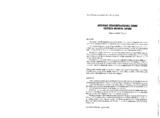Algunas consideraciones sobre estética musical árabe
Autor
Cortés García, Manuela
Editor
UCOPressFecha
1999Materia
Música medieval árabeMúsica andalusí
METS:
Mostrar el registro METSPREMIS:
Mostrar el registro PREMISMetadatos
Mostrar el registro completo del ítemResumen
En principio, Ia poesía considerada como génesis del arte árabe, y, más tarde, Ia prosa de adab surgieron
con Ia idea de ciencia que destacaba el dominio de Ia belleza, idea que se proyectaría después sobre Ia música.
Por otra parte, Ia aportación griega al legado filosófico y científico árabe clásico, cuya sombra aparece
reflejada sobre los primeros tratados de los filósofos y teóricos musicales, entre los que se encuentran alKindf
(s. IX) y al-Farabf (s. X), germino en Ia concepción de un nuevo sentido sobre Ia <<belleza».
De esta forma, y desde un observatorio que tiene como punto de referencia el mundo clásico griego, los
nuevos parametros surgirán como consecuencia de su propia identidad e idiosincrasia, en los que el patrimonio
poético y musical, unido al pensamiento religioso y filosófico, complementarán Ia taracea de un nuevo
concepto, <<estética musical».
El estudio de Ia música medieval áarabe revela que Ia armonía entre el contenido poético, lingüístico, rítmico
y melódico caminaron en paralelo, produciéndose un equilibrio, una relación armónica, y, en definitiva
cósmica que les llevo a acuñar un cierto ideal estético basado en Ia belleza y Ia emoción artística que despertaba
como reflejo de una armonía entre cuerpo y alma, y que facilitaría Ia unión con lo infinito y Ia divinidad. At the beginning, the poetry was considered as the genesis of the arabic art, and after then the prose of
adab, both of them appeared with the idea of the <<beauty science>>. This idea would be projected on the music.
On the other hand, the greek heritage of the classic arabic philosophy legacy was reflected during the
first manuscripts of the arabic philosophers and musical theoreticians as al-Kindf (s.IX) and al-Farabf (s.X),
as a result appeared a new conception of the <<beauty>> and <<aesthetic>>.
By this way, taking as a point of reference the greek classical world, the new parameters would appear
as an result of this own reality and idiosyncrasy. Their poetry and musical legacy, joined to the philosopher
and religious mind would complete the work of the <<aesthetic musical art>>.
The study of the arabic middle music prove that the harmony in the poetry, lingUistic and rhitmycal contents,
go in parallel with the melodic content until it reached a harmonic relation and in definitive cosmic, and
as a result an <<aesthetic ideal>>. This ideal was based on <<beauty>> and the <<aesthetic emotion>> produced by
the art and all that as reflet to the harmonic until the corp and the spirit and oriented to the spherical work and
to the divinity.

